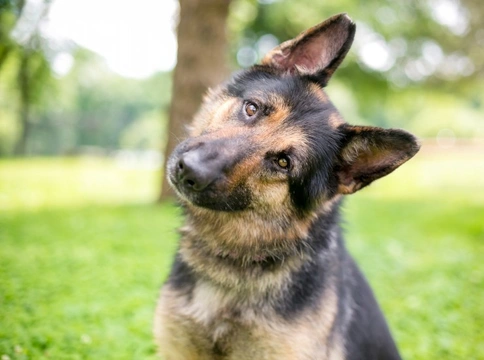
Dogs and eye contact – when to use it
Dogs communicate with each other in a whole range of ways, many of which are very different to how we as people communicate and interact. Body language is a key element of canine communication, as is eye contact (or the lack of it) as well as vocalisations, touch, and of course, scent.
Because dogs have lived side by side with humans for thousands of years, they have actually evolved to moderate and change their methods of communication when dealing with humans rather than when dealing with other dogs, in order to better enable us to understand each other and get along.
However, we as humans are still not great at decoding canine body language and communication signals, and we tend to apply a very human filter to doing so. This means that when we’re trying to interpret the meaning of something a dog does, we think in human terms – and often get things wrong.
A classical example of this comes from people who tell their dogs off for something, and the dog looks away and very deliberately avoids eye contact when they do so. The handler in question reads this as the dog’s indication of guilt – when in fact the dog is submitting and trying to appease their owner as a yielding gesture, and not making an admission of guilt for a telling off they may not fully understand.
Direct eye contact when speaking to another person is expected in human interactions and considered to indicate honesty and engagement, but for dogs, direct eye contact can be read as dominance, a threat, or a challenge.
This means that how and when we make eye contact with dogs, and how and when we should avoid it, is something that we need to learn to understand and practice applying, which is what we will look at within this article.
Read on to learn more about how eye contact is read and interpreted by dogs, and when to make eye contact – and when not to.
Direct eye contact, it’s meanings and applications
There are a few scenarios in which dogs will deliberately make eye contact with another dog or person, but direct eye contact isn’t an ongoing part of how dogs interact with each other as part of their normal day.
Making direct eye contact with another dog can be read as a challenge – the dog initiating the interaction may be telling the other dog that they intend to be the boss or alpha, which then provides the other dog with the opportunity to yield dominance and look away, or to take up the challenge and let the first dog know by return of eye contact that they’re going to have to argue over who is really boss.
Dogs that tend to be reactive or aggressive with other dogs often begin with making direct eye contact, and the reasons for this can be variable, and usually apply to dogs that aren’t used to normal socialisation, or that have had bad experiences with other dogs and so, give off defensive or unfriendly body language themselves.
By making direct eye contact in this way, the dog in question is warning the other dog off, or trying in their own way to avoid contact with the other dog by coming over as hostile and not receptive to an approach.
When it comes to people and deliberately making eye contact with dogs, there are a limited range of scenarios in which this is appropriate to the situation. If you need to get your dog’s attention and are calling or gesturing to them, eye contact can help to focus your dog’s attention on you. However, use eye contact to gain your dog’s attention, but don’t turn it into a stare!
If you need to check your dog or tell them off because they’re being unruly or doing something they shouldn’t, clear and direct eye contact for a couple of seconds can help to let your dog know that you are serious, and are playing the pack leader card. This will often be sufficient to curb your dog’s enthusiasm and make them pay attention to you, because this direct eye contact lets them know that you mean business.
Your dog should look away, and break eye contact as a sign of yielding.
Avoiding eye contact and its interpretations
Avoiding eye contact between dogs lets the other party know several things – it can tell them that they are not a threat, and/or that they yield to the other party. When we’re approaching a dog or trying to get their attention, we tend to fixate on them with widened eyes and a smile to show encouragement and sincerity, but this can actually be very daunting for dogs – particularly shy or nervous ones.
Evading eye contact when a dog initiates it may be read by the other dog as a submissive gesture, and this isn’t generally something we want to give to dogs. However, for a dog that doesn’t know you or that is shy or nervous and that is avoiding eye contact themselves, you can make a better approach to them and particularly, encourage them to come to you by avoiding direct eye contact and speaking encouragingly.
Try to keep your smile from displaying your teeth too, which is another signal that dogs may interpret as a bared-teeth growl!



